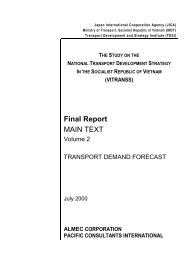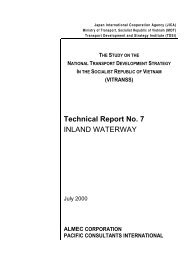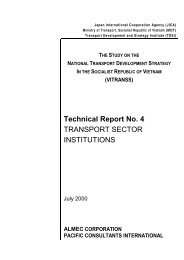Technical Report No. 8 PORT AND SHIPPING
Technical Report No. 8 PORT AND SHIPPING
Technical Report No. 8 PORT AND SHIPPING
You also want an ePaper? Increase the reach of your titles
YUMPU automatically turns print PDFs into web optimized ePapers that Google loves.
Introduction<br />
I-4-10<br />
Vietnam National Transport Strategy Study (VITRANSS)<br />
<strong>Technical</strong> <strong>Report</strong> <strong>No</strong>. 8<br />
Shipping and Ports<br />
The concept of building a specialized port for the transshipment of containers in<br />
Vietnam comes from the following observations:<br />
1) Container shipping is booming, particularly in Asia;<br />
2) The shipping strategy for mega carriers leads to the use of bigger vessels<br />
which require deeper water ports;<br />
3) Regional hub ports, Hong Kong and Singapore, enjoy increasing container<br />
traffic volume, while land scarcity becomes apparent.<br />
4) Vietnam is located between Hong Kong and Singapore and endowed with a<br />
long coastline, thus offering favorable alternative sites from a nautical point of<br />
view.<br />
5) If a regional transshipment port is situated in Vietnam, shippers and<br />
consignees will benefit from direct shipping services with many overseas<br />
markets.<br />
It is Vietnam’s hope and many Asian countries’ as well that with an available<br />
transshipment port in their respective territories the present demand on<br />
Singapore and Hong Kong for transshipment services will spill over to them.<br />
Table 4.2.1<br />
Relational Distances among the Major Ports in the Region<br />
Ports Hong Kong Vung Tau<br />
(unit: km)<br />
Singapore<br />
Kaohsiung 719 2,003 3,317<br />
Manila 1,172 1,700 2,422<br />
Cebu 1,780 2,142 2,560<br />
Vung Tau 1,625 - 1,120<br />
Kota Kinabalu 2,010 1,329 1,600<br />
Bangkok 2,760 1,207 2,226<br />
Singapore 2,650 1,120 -<br />
Jakarta 987 1,875 3,310<br />
International Container Shipping Business<br />
Container traffic has continuously grown since its appearance in the 1960s. In<br />
1980, international ports in total handled 36 million TEU whilst they recorded 138<br />
million TEU in 1995. It should be noted that the ports at least double count the<br />
number of global container movements while they handle substantial LCL (less<br />
than container load) and empty containers and the containers in transshipment. It<br />
is therefore estimated that the total number of full, international shipping<br />
containers in 1995 was 50 million TEU. The UN ESCAP 1 forecasts that this total<br />
1 UN ESCAP “Intraregional Container Shipping Study, 1997”












